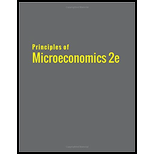
PRINCIPLES OF MICROECONOMICS (OER)
2nd Edition
ISBN: 9781947172340
Author: Timothy Taylor, Steven A. Greenlaw
Publisher: OpenStax
expand_more
expand_more
format_list_bulleted
Textbook Question
Chapter 15, Problem 9SCQ
Using two
Expert Solution & Answer
Want to see the full answer?
Check out a sample textbook solution
Students have asked these similar questions
Graph shows the daily market price of jeans when the tax on sellers is set to zero per pair supposed the government institutes attacks of $20.30 per pair to be paid by the seller what is the quantity after tax
How do you figure out tax incidents in elasticity
not use ai please
Chapter 15 Solutions
PRINCIPLES OF MICROECONOMICS (OER)
Ch. 15 - Describe how each of these changes is likely to...Ch. 15 - Jonathan is a single father with one child. He can...Ch. 15 - Imagine that the government reworks the welfare...Ch. 15 - We have discovered that the welfare system...Ch. 15 - How does the TANF attempt to loosen the poverty...Ch. 15 - A group 0f 10 people have the following annual...Ch. 15 - Table 15.9 shows the share of income going to each...Ch. 15 - Using two demand and supply diagrams, one for the...Ch. 15 - Using two demand and supply diagrams, one for the...Ch. 15 - Here is one hypothesis: A well-funded social...
Ch. 15 - Here is a second hypothesis: A well-funded social...Ch. 15 - Which set of policies is more likely to cause a...Ch. 15 - Why is there reluctance on the part of some in the...Ch. 15 - How is the poverty rate calculated?Ch. 15 - What is the poverty line?Ch. 15 - What is the difference between poverty and income...Ch. 15 - How does the poverty trap discourage people from...Ch. 15 - How can the effect of the poverty trap be reduced?Ch. 15 - Who are the near-poor?Ch. 15 - What is the safety net?Ch. 15 - Briefly explain the differences between TANF, the...Ch. 15 - Who is included in the top income quintile?Ch. 15 - What is measured on the two axes of a Lorenz...Ch. 15 - If a country had perfect income equality what...Ch. 15 - How has the inequality of income changed in the...Ch. 15 - What are some reasons why a certain degree of...Ch. 15 - What are the main reasons economists give for the...Ch. 15 - Identify some public policies that can reduce the...Ch. 15 - Describe how a push for economic equality might...Ch. 15 - What goods and services would you include in an...Ch. 15 - If a family of three earned 20,000, would they be...Ch. 15 - Exercise 15.2 and Exercise 15.3 asked you to...Ch. 15 - Explain how you would create a government program...Ch. 15 - Many critics of government programs to help...Ch. 15 - Think about the business cycle: during a...Ch. 15 - Explain how a country may experience greater...Ch. 15 - The demand for skilled workers in the United...Ch. 15 - Explain a situation using the supply and demand...Ch. 15 - What do you think is more important to focus on...Ch. 15 - To reduce income inequality, should the marginal...Ch. 15 - Redistribution of income occurs through the...Ch. 15 - How does a society or a country make the decision...Ch. 15 - Explain what the long- and short-term consequences...Ch. 15 - In country A, the population is 300 million and 50...Ch. 15 - In country B, the population is 900 million and...Ch. 15 - Susan is a single mother with three children. She...Ch. 15 - A group of 10 people have the following annual...
Additional Business Textbook Solutions
Find more solutions based on key concepts
A company has the opportunity to take over a redevelopment project in an industrial area of a city. No immediat...
Engineering Economy (17th Edition)
Horizontal analysis(Learning Objective 2)15-20 min. Below are net sales and net income data for a five-year per...
Financial Accounting, Student Value Edition (5th Edition)
Discussion Questions 1. What characteristics of the product or manufacturing process would lead a company to us...
Managerial Accounting (5th Edition)
In the firm the stock is actively traded in the securities markets need not concern in the diversification and ...
Gitman: Principl Manageri Finance_15 (15th Edition) (What's New in Finance)
S6-2 Determining inventory costing methods
Ward Hard ware does not expect costs to change dramatically and want...
Horngren's Financial & Managerial Accounting, The Financial Chapters (Book & Access Card)
E6-14 Using accounting vocabulary
Learning Objective 1, 2
Match the accounting terms with the corresponding d...
Horngren's Accounting (12th Edition)
Knowledge Booster
Similar questions
- Not use ai pleasearrow_forwardHelp me write these economic analysis for Macys one paragraph) Company name/current state of operation of this company - Describe the company's performance in the present economy, whether it is growing or declining, and who are its competitors?arrow_forwardnot use ai pleasearrow_forward
arrow_back_ios
SEE MORE QUESTIONS
arrow_forward_ios
Recommended textbooks for you



 Microeconomics: Private and Public Choice (MindTa...EconomicsISBN:9781305506893Author:James D. Gwartney, Richard L. Stroup, Russell S. Sobel, David A. MacphersonPublisher:Cengage Learning
Microeconomics: Private and Public Choice (MindTa...EconomicsISBN:9781305506893Author:James D. Gwartney, Richard L. Stroup, Russell S. Sobel, David A. MacphersonPublisher:Cengage Learning Economics: Private and Public Choice (MindTap Cou...EconomicsISBN:9781305506725Author:James D. Gwartney, Richard L. Stroup, Russell S. Sobel, David A. MacphersonPublisher:Cengage Learning
Economics: Private and Public Choice (MindTap Cou...EconomicsISBN:9781305506725Author:James D. Gwartney, Richard L. Stroup, Russell S. Sobel, David A. MacphersonPublisher:Cengage Learning




Microeconomics: Private and Public Choice (MindTa...
Economics
ISBN:9781305506893
Author:James D. Gwartney, Richard L. Stroup, Russell S. Sobel, David A. Macpherson
Publisher:Cengage Learning

Economics: Private and Public Choice (MindTap Cou...
Economics
ISBN:9781305506725
Author:James D. Gwartney, Richard L. Stroup, Russell S. Sobel, David A. Macpherson
Publisher:Cengage Learning
